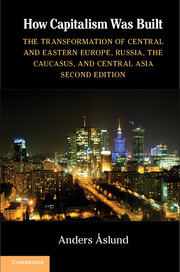 How Capitalism Was Built
How Capitalism Was Built Book contents
- Frontmatter
- Contents
- List of Tables and Figures
- Acknowledgments
- List of Abbreviations
- Introduction
- 1 Communism and Its Demise
- 2 Radical Reform versus Gradualism
- 3 Output
- 4 Liberalization
- 5 From Hyperinflation to Financial Stability
- 6 Privatization
- 7 The Social System
- 8 The Politics of Transition
- 9 From Crime Toward Law
- 10 The Importance of the European Union
- 11 The Global Financial Crisis, 2007–2012
- 12 Conclusions
- Bibliography
- Index
Introduction
A World Transformed
Published online by Cambridge University Press: 05 December 2012
- Frontmatter
- Contents
- List of Tables and Figures
- Acknowledgments
- List of Abbreviations
- Introduction
- 1 Communism and Its Demise
- 2 Radical Reform versus Gradualism
- 3 Output
- 4 Liberalization
- 5 From Hyperinflation to Financial Stability
- 6 Privatization
- 7 The Social System
- 8 The Politics of Transition
- 9 From Crime Toward Law
- 10 The Importance of the European Union
- 11 The Global Financial Crisis, 2007–2012
- 12 Conclusions
- Bibliography
- Index
Summary
Sunday June 4, 1989, was a sunny day in Moscow. My host woke me up to tell me that Ayatollah Khomeini had died, but that was only the third item on the BBC World Service because on that very day the Chinese communist dictators massacred democratic protesters on Tiananmen Square, and Poland held partially democratic parliamentary elections. For me, the Polish elections were the most important news, signaling that communism ended on that day, whereas the Chinese massacre showed that a democratic outcome was by no means a given. Soon, one communist domino after another was to fall.
This was an extraordinary time. A complete ideological, political, economic, and social system was about to pass away, and a large part of the world with some 400 million inhabitants was to choose a new shape in every regard, including what countries they should divide themselves into. The Soviet bloc – from Berlin to Vladivostok – was struck by one of the greatest liberal revolutions of all times. Since then, society has changed profoundly. The rejection of socialism was unequivocal. A broad consensus aspired to build democracy and a market economy based on private ownership and the rule of law.
At the collapse of communism, liberal revolutionaries seized the political initiative. They aspired to build a “normal society” and to “return to Europe.” The petrified communist dictatorships had to give way to democracy and individual freedom, the state-controlled economy to markets, and public ownership to private property. Communism had rejected the rule of law, which now should be established. A total transformation was needed, and nobody thought it would be easy.
- Type
- Chapter
- Information
- How Capitalism Was BuiltThe Transformation of Central and Eastern Europe, Russia, the Caucasus, and Central Asia, pp. 1 - 13Publisher: Cambridge University PressPrint publication year: 2012


